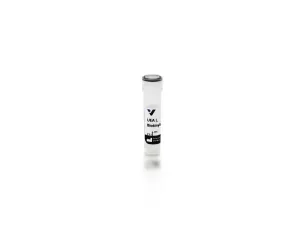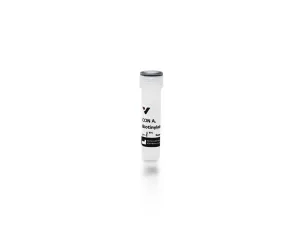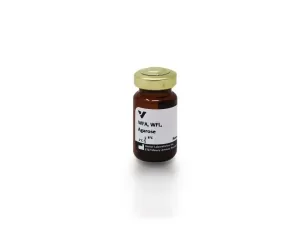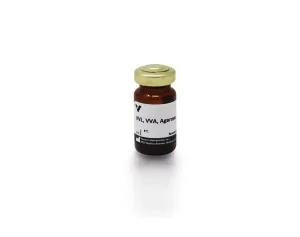Vector Laboratories is closed for the President’s Day on Monday, February 19th. We will be back in the office on Tuesday, February 20th.
We will respond to emails upon our return. Have a wonderful day.
Menu
Vector Laboratories is closed for the President’s Day on Monday, February 19th. We will be back in the office on Tuesday, February 20th.
We will respond to emails upon our return. Have a wonderful day.
Agarose bound Galanthus nivalis lectin is prepared using our affinity-purified lectins. Galanthus nivalis lectin, unlike most mannose-specific lectins, is not a metalloprotein and does not require Ca++ or Mn++ for binding. Binding seems to be preferentially directed toward structures containing (α-1,3) mannose residues.
In contrast to most mannose-binding lectins, GNL will not bind α-linked glucose. Reports indicate that this lectin binds rat and mouse IgM but not IgG. The only protein from human serum reported to bind to this lectin is α2-macroglobulin. GNL binds to many viral glycoproteins.
| Unit Size | 5 ml |
|---|---|
| Applications | Glycobiology, Affinity Chromatography |
| Recommended Storage | 2-8 °C DO NOT FREEZE |
| Solution | 10 mM HEPES, pH 7.5, 0.15 M NaCl, 0.1 mM CaCl2, 0.01 mM MnCl2, 20 mM mannose, 0.08% sodium azide |
| Recommended Usage | Wash gel thoroughly with buffer before use to remove sugar added to stabilize the lectin. Recommended product for eluting glycoconjugates bound to this agarose-lectin: Glycoprotein Eluting Solution, Cat. No. ES-1100. Alternatively, 0.1 M α methyl mannoside can be used.For those glycoconjugates having a very high affinity for GNL, it may be necessary to lower the pH of the eluting sugar solution to pH 4.0 with acetic acid and increase the concentration of the α methyl mannoside to 0.5 M. After use, wash the gel with several column volumes of buffered saline, then resuspend gel in buffered saline containing 0.08% sodium azide for storage. |
| Matrix Conjugate | Lectins |
| Sugar Specificity | Mannose |
| Conjugate | Agarose |
Our agarose lectin products are supplied as hydrated matrix solutions in amber glass bottles. The agarose (bead) material will settle and you will see two phases in the tube supplied. The upper phase is buffer. A column can be prepared in a commercial plastic device such as Bio-Rad Cat # 732-6008 or an inverted Pasteur pipet with glass wool lightly packed in the neck to retain the agarose. 1) Draw (pipet) the desired amount of settled agarose-lectin (gel) from the stock bottle into the prepared column and let the buffer drain by gravity.(Sometimes an air bubble in the column tip prevents flow; tapping the column should get the flow started). 2) Wash the gel with 10 column volumes of buffer, such as HBS (10 mM HEPES, 0.15 M NaCl, pH 7.5) and discard the flow through. 3) Place a collection vessel (e.g. glass test tube) under the column tip and apply the glycoprotein-containing solution.Allow the solution to drain through using gravity. We recommend against pushing or pulling the material through the column. Retain the flow through material until the desired binding has been confirmed. 4) After sample application, wash column with 2-3 column volumes of buffer (or until the absorbance at 280nm is reduced to a satisfactory level) to remove unbound materials before elution. 5) Place a fresh collection vessel under the column tip.Apply the eluting solution again letting gravity do the work of moving the solution over the column. Note that in some cases, several column volumes of eluting solution may be required to achieved adequate release of bound material. 6) Following elution, the column can be prepared for reuse by washing with 10 column volumes of buffer. 7) If the column is to be stored, equilibrate the column with buffer containing 0.08% sodium azide. Cover the column with a plastic wrap, or similar, to prevent desiccation and keep at 4 degrees Celsius. The column will be stable for many months when stored under these conditions.
The pH should be near neutral, the maximum pressure for packing the resin is 10 psi, and the maximum flow rate 3.5 ml/min.
Our coupling method provides several advantages over the traditional cyanogen bromide procedure:
Our agarose bound lectins are supplied at a constant concentration of lectin per ml of settled beads. The concentration for each lectin is selected to achieve the highest glycoconjugate binding capacity per mg of lectin present in the beads. Each lot is tested for its binding capacity using glycoproteins known to bind the lectin. This provides a guideline for the user and assures the quality of our agarose bound lectins.
Inhibiting/Eluting Sugar: 100 mM – 200 mM α-methylmannoside
Applicable patents and legal notices are available at legal notices.




Stay in the Loop. Join Our Online Community
Together we breakthroughTM

©Vector Laboratories, Inc. 2024 All Rights Reserved.
How do I Request a Quote?
To request a quote for products: